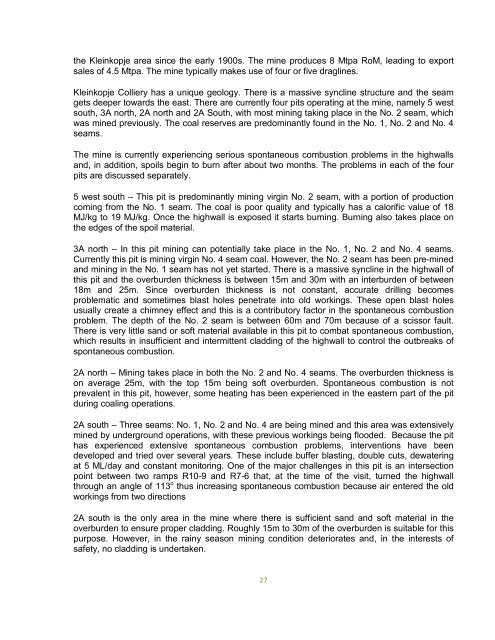prevention and control of spontaneous combustion - Mining and
prevention and control of spontaneous combustion - Mining and
prevention and control of spontaneous combustion - Mining and
Create successful ePaper yourself
Turn your PDF publications into a flip-book with our unique Google optimized e-Paper software.
the Kleinkopje area since the early 1900s. The mine produces 8 Mtpa RoM, leading to export<br />
sales <strong>of</strong> 4.5 Mtpa. The mine typically makes use <strong>of</strong> four or five draglines.<br />
Kleinkopje Colliery has a unique geology. There is a massive syncline structure <strong>and</strong> the seam<br />
gets deeper towards the east. There are currently four pits operating at the mine, namely 5 west<br />
south, 3A north, 2A north <strong>and</strong> 2A South, with most mining taking place in the No. 2 seam, which<br />
was mined previously. The coal reserves are predominantly found in the No. 1, No. 2 <strong>and</strong> No. 4<br />
seams.<br />
The mine is currently experiencing serious <strong>spontaneous</strong> <strong>combustion</strong> problems in the highwalls<br />
<strong>and</strong>, in addition, spoils begin to burn after about two months. The problems in each <strong>of</strong> the four<br />
pits are discussed separately.<br />
5 west south – This pit is predominantly mining virgin No. 2 seam, with a portion <strong>of</strong> production<br />
coming from the No. 1 seam. The coal is poor quality <strong>and</strong> typically has a calorific value <strong>of</strong> 18<br />
MJ/kg to 19 MJ/kg. Once the highwall is exposed it starts burning. Burning also takes place on<br />
the edges <strong>of</strong> the spoil material.<br />
3A north – In this pit mining can potentially take place in the No. 1, No. 2 <strong>and</strong> No. 4 seams.<br />
Currently this pit is mining virgin No. 4 seam coal. However, the No. 2 seam has been pre-mined<br />
<strong>and</strong> mining in the No. 1 seam has not yet started. There is a massive syncline in the highwall <strong>of</strong><br />
this pit <strong>and</strong> the overburden thickness is between 15m <strong>and</strong> 30m with an interburden <strong>of</strong> between<br />
18m <strong>and</strong> 25m. Since overburden thickness is not constant, accurate drilling becomes<br />
problematic <strong>and</strong> sometimes blast holes penetrate into old workings. These open blast holes<br />
usually create a chimney effect <strong>and</strong> this is a contributory factor in the <strong>spontaneous</strong> <strong>combustion</strong><br />
problem. The depth <strong>of</strong> the No. 2 seam is between 60m <strong>and</strong> 70m because <strong>of</strong> a scissor fault.<br />
There is very little s<strong>and</strong> or s<strong>of</strong>t material available in this pit to combat <strong>spontaneous</strong> <strong>combustion</strong>,<br />
which results in insufficient <strong>and</strong> intermittent cladding <strong>of</strong> the highwall to <strong>control</strong> the outbreaks <strong>of</strong><br />
<strong>spontaneous</strong> <strong>combustion</strong>.<br />
2A north – <strong>Mining</strong> takes place in both the No. 2 <strong>and</strong> No. 4 seams. The overburden thickness is<br />
on average 25m, with the top 15m being s<strong>of</strong>t overburden. Spontaneous <strong>combustion</strong> is not<br />
prevalent in this pit, however, some heating has been experienced in the eastern part <strong>of</strong> the pit<br />
during coaling operations.<br />
2A south – Three seams: No. 1, No. 2 <strong>and</strong> No. 4 are being mined <strong>and</strong> this area was extensively<br />
mined by underground operations, with these previous workings being flooded. Because the pit<br />
has experienced extensive <strong>spontaneous</strong> <strong>combustion</strong> problems, interventions have been<br />
developed <strong>and</strong> tried over several years. These include buffer blasting, double cuts, dewatering<br />
at 5 ML/day <strong>and</strong> constant monitoring. One <strong>of</strong> the major challenges in this pit is an intersection<br />
point between two ramps R10-9 <strong>and</strong> R7-6 that, at the time <strong>of</strong> the visit, turned the highwall<br />
through an angle <strong>of</strong> 113 o thus increasing <strong>spontaneous</strong> <strong>combustion</strong> because air entered the old<br />
workings from two directions<br />
2A south is the only area in the mine where there is sufficient s<strong>and</strong> <strong>and</strong> s<strong>of</strong>t material in the<br />
overburden to ensure proper cladding. Roughly 15m to 30m <strong>of</strong> the overburden is suitable for this<br />
purpose. However, in the rainy season mining condition deteriorates <strong>and</strong>, in the interests <strong>of</strong><br />
safety, no cladding is undertaken.<br />
27

















